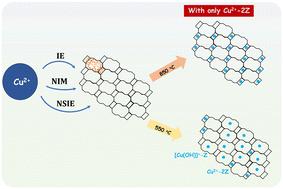不同制备方法制备的Cu-SSZ-13催化剂NH3-SCR活性和耐SO2性能的新见解
IF 4.2
3区 化学
Q2 CHEMISTRY, PHYSICAL
引用次数: 0
摘要
Cu- ssz -13催化剂中Cu的负载和Cu的形态对NH3-SCR活性和水热稳定性有重要影响,而Cu的引入方式往往会影响催化剂的负载和形态。然而,当本研究将Cu负载控制在相同水平时,发现新型浸渍法(NIM)、固态离子交换法(SSIE)和液体离子交换法(IE)的制备方法均不影响所制备Cu- ssz -13的水热稳定性,因为[Cu(OH)]+ -Z在水热老化过程中转化为Cu2+ -2Z。因此,所有老化Cu-SSZ-13催化剂具有相同的NH3-SCR活性。Cu- ssz -13催化剂的抗SO2性能与催化剂中Cu的种类有关。仅含Cu2+ -2Z的硫化Cu- ssz - 13850催化剂(850℃煅烧)优于同时含[Cu(OH)]+ -Z和Cu2+ -2Z的硫化Cu- ssz - 13550催化剂(550℃煅烧),因为Cu2+ -2Z可以保持Cu2+离子的SCR活性,而[Cu(OH)]+ -Z则不能。与IE相比,我们小组提出的NIM和SSIE方法可以显著减少合成cu交换沸石催化剂所需的时间和资金。将NIM(或SSIE)法与高温煅烧相结合,可以轻松合成同时具有优异水热稳定性和SO2抗性的Cu-SSZ-13催化剂。本文章由计算机程序翻译,如有差异,请以英文原文为准。

New insights into the NH3-SCR activity and SO2 resistance of Cu-SSZ-13 catalysts prepared by different methods†
The Cu loading and Cu species in Cu-SSZ-13 catalysts, which are very important for the NH3-SCR activity and hydrothermal stability, are usually affected by the method of introducing Cu. However, when the Cu loading was carefully controlled at the same level in this study, it was found that the preparation methods, including the novel impregnation method (NIM), solid-state ion exchange method (SSIE), and liquid ion exchange (IE), did not affect the hydrothermal stability of the prepared Cu-SSZ-13, since the [Cu(OH)]+–Z species converts to Cu2+–2Z during the hydrothermal aging process. Thus, all aged Cu-SSZ-13 catalysts possessed the same NH3-SCR activity. The SO2 resistance of a Cu-SSZ-13 catalyst is related to the Cu species present in the catalyst. Sulfated Cu-SSZ-13 850 catalysts (calcined at 850 °C) containing only Cu2+–2Z outperformed sulfated Cu-SSZ-13 550 catalysts (calcined at 550 °C) containing both [Cu(OH)]+–Z and Cu2+–2Z, since Cu2+–2Z species can maintain their SCR activity as Cu2+ ions while [Cu(OH)]+–Z do not. The NIM and SSIE methods proposed by our group can significantly reduce the time and capital needed to synthesize Cu-exchanged zeolite catalysts, compared with IE. Combining the NIM (or SSIE) method with high-temperature calcination, Cu-SSZ-13 catalysts possessing excellent hydrothermal stability and SO2 resistance simultaneously can easily be synthesized.
求助全文
通过发布文献求助,成功后即可免费获取论文全文。
去求助
来源期刊

Catalysis Science & Technology
CHEMISTRY, PHYSICAL-
CiteScore
8.70
自引率
6.00%
发文量
587
审稿时长
1.5 months
期刊介绍:
A multidisciplinary journal focusing on cutting edge research across all fundamental science and technological aspects of catalysis.
Editor-in-chief: Bert Weckhuysen
Impact factor: 5.0
Time to first decision (peer reviewed only): 31 days
 求助内容:
求助内容: 应助结果提醒方式:
应助结果提醒方式:


